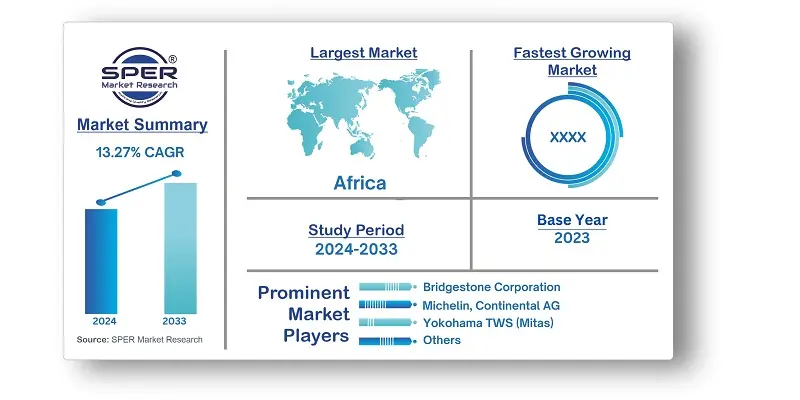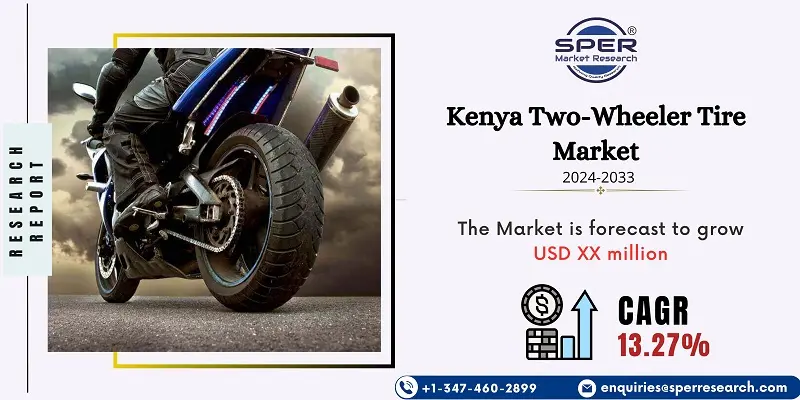
Kenya Two-Wheeler Tire Market Growth, Size, Trends, Business Challenges and Future Outlook
Kenya Two-Wheeler Tire Market Size - By Vehicle Type, By Demand Type, By Price Category, By Tire Type, By Sales Channel - Regional Outlook, Competitive Strategies and Segment Forecast to 2033
| Published: Jul-2024 | Report ID: AMIN24160 | Pages: 1 - 109 | Formats*: |
| Category : Automotive & Transportation | |||
- In 2021, Goodyear debuted two further sizes of the ultra-high-performance (UHP) ElectricDrive GT tyre in addition to a new ElectricDrive all-season tyre. The product is mainly intended for commuter touring sedans and crossover utility vehicles. It is equipped with a load index that shows a stronger potential to withstand the heavier weight associated with electric vehicles. The tire's asymmetric tread pattern also helps it handle very well in a variety of weather conditions. In 2022, the company declared that it would launch the Goodyear ElectricDrive GT, which comes in 255/45R19 104W XL size, as part of its intentions to broaden its product line.


| Report Metric | Details |
| Market size available for years | 2020-2033 |
| Base year considered | 2023 |
| Forecast period | 2024-2033 |
| Segments covered | By Vehicle Type, By Demand Type, By Price Category, By Tire Type, By Sales Channel |
| Regions covered | Eastern, Northern, Southern, Western |
| Companies Covered | Bridgestone Corporation, Michelin, Continental AG, Yokohama TWS (Mitas), Pirelli Tyre S.p.A, Dunlop Tyres, MRF, Shinko Tyres, CEAT. |
- Motorcycle Owners
- Scooter Owners
- Delivery Service Providers
- Ride-Hailing Services
- Motorcycle Taxi Operators (Boda Boda Riders)
- Agricultural Sector Workers
- Tourism and Rental Services
- Retailers and Distributors
- Repair and Maintenance Shops
- Fleet Management Companies
| By Vehicle Type: |
|
| By Demand Type: |
|
| By Price Category: |
|
| By Tire Type: |
|
| By Sales Channel: |
|
- Kenya Two-Wheeler Tire Market Size (FY’2024-FY’2033)
- Overview of Kenya Two-Wheeler Tire Market
- Segmentation of Kenya Two-Wheeler Tire Market By Vehicle Type (Scooter & Moped, Motorcycle)
- Segmentation of Kenya Two-Wheeler Tire Market By Demand Type (OEMs, Replacement)
- Segmentation of Kenya Two-Wheeler Tire Market By Price Category (Budget, Economy, Premium)
- Segmentation of Kenya Two-Wheeler Tire Market By Tire Type (Radial, Bias)
- Segmentation of Kenya Two-Wheeler Tire Market By Sales Channel (Online, Multi-brand Stores, Exclusive Outlets, Direct)
- Statistical Snap of Kenya Two-Wheeler Tire Market
- Expansion Analysis of Kenya Two-Wheeler Tire Market
- Problems and Obstacles in Kenya Two-Wheeler Tire Market
- Competitive Landscape in the Kenya Two-Wheeler Tire Market
- Impact of COVID-19 and Demonetization on Kenya Two-Wheeler Tire Market
- Details on Current Investment in Kenya Two-Wheeler Tire Market
- Competitive Analysis of Kenya Two-Wheeler Tire Market
- Prominent Players in the Kenya Two-Wheeler Tire Market
- SWOT Analysis of Kenya Two-Wheeler Tire Market
- Kenya Two-Wheeler Tire Market Future Outlook and Projections (FY’2024-FY’2033)
- Recommendations from Analyst
1.1. Scope of the report1.2. Market segment analysis
2.1. Research data source
2.1.1. Secondary Data2.1.2. Primary Data2.1.3. SPER’s internal database2.1.4. Premium insight from KOL’s
2.2. Market size estimation
2.2.1. Top-down and Bottom-up approach
2.3. Data triangulation
4.1. Driver, Restraint, Opportunity and Challenges analysis
4.1.1. Drivers4.1.2. Restraints4.1.3. Opportunities4.1.4. Challenges
4.2. COVID-19 Impacts of the Kenya Two-Wheeler Tire Market.
5.1. SWOT Analysis
5.1.1. Strengths5.1.2. Weaknesses5.1.3. Opportunities5.1.4. Threats
5.2. PESTEL Analysis
5.2.1. Political Landscape5.2.2. Economic Landscape5.2.3. Social Landscape5.2.4. Technological Landscape5.2.5. Environmental Landscape5.2.6. Legal Landscape
5.3. PORTER’s Five Forces
5.3.1. Bargaining power of suppliers5.3.2. Bargaining power of buyers5.3.3. Threat of Substitute5.3.4. Threat of new entrant5.3.5. Competitive rivalry
5.4. Heat Map Analysis
6.1. Kenya Two-Wheeler Tire Market Manufacturing Base Distribution, Sales Area, Product Type6.2. Mergers & Acquisitions, Partnerships, Product Launch, and Collaboration in Kenya Two-Wheeler Tire Market
7.1. Kenya Two-Wheeler Tire Market Size, Share and Forecast, By Vehicle Type, 2020-20267.2. Kenya Two-Wheeler Tire Market Size, Share and Forecast, By Vehicle Type, 2027-20337.3. Scooter & Moped7.4. Motorcycle
8.1. Kenya Two-Wheeler Tire Market Size, Share and Forecast, By Demand Type, 2020-20268.2. Kenya Two-Wheeler Tire Market Size, Share and Forecast, By Demand Type, 2027-20338.3. OEMs8.4. Replacement
9.1. Kenya Two-Wheeler Tire Market Size, Share and Forecast, By Price Category, 2020-20269.2. Kenya Two-Wheeler Tire Market Size, Share and Forecast, By Price Category, 2027-20339.3. Budget (Up to USD 11 Per Unit)9.4. Economy (USD 12 to 30 Per unit)9.5. Premium (Above USD 30 Per Unit)
10.1. Kenya Two-Wheeler Tire Market Size, Share and Forecast, By Tire Type, 2020-202610.2. Kenya Two-Wheeler Tire Market Size, Share and Forecast, By Tire Type, 2027-203310.3. Radial10.4. Bias
11.1. Kenya Two-Wheeler Tire Market Size, Share and Forecast, By Sales Channel, 2020-202611.2. Kenya Two-Wheeler Tire Market Size, Share and Forecast, By Sales Channel, 2027-203311.3. Online11.4. Multi-brand Stores11.5. Exclusive Outlets11.6. Direct
12.1. Kenya Two-Wheeler Tire Market Size and Market Share
13.1. Kenya Two-Wheeler Tire Market Size and Market Share By Region (2020-2026)13.2. Kenya Two-Wheeler Tire Market Size and Market Share By Region (2027-2033)13.3. Eastern13.4. Northern13.5. Southern13.6. Western
14.1. Bridgestone Corporation
14.1.1. Company details14.1.2. Financial outlook14.1.3. Product summary14.1.4. Recent developments
14.2. Michelin
14.2.1. Company details14.2.2. Financial outlook14.2.3. Product summary14.2.4. Recent developments
14.3. Continental AG
14.3.1. Company details14.3.2. Financial outlook14.3.3. Product summary14.3.4. Recent developments
14.4. Yokohama TWS
14.4.1. Company details14.4.2. Financial outlook14.4.3. Product summary14.4.4. Recent developments
14.5. Pirelli Tyre S.p.A
14.5.1. Company details14.5.2. Financial outlook14.5.3. Product summary14.5.4. Recent developments
14.6. Dunlop Tyres
14.6.1. Company details14.6.2. Financial outlook14.6.3. Product summary14.6.4. Recent developments
14.7. MRF
14.7.1. Company details14.7.2. Financial outlook14.7.3. Product summary14.7.4. Recent developments
14.8. Shinko Tyres
14.8.1. Company details14.8.2. Financial outlook14.8.3. Product summary14.8.4. Recent developments
14.9. CEAT
14.9.1. Company details14.9.2. Financial outlook14.9.3. Product summary14.9.4. Recent developments
14.10. Others
SPER Market Research’s methodology uses great emphasis on primary research to ensure that the market intelligence insights are up to date, reliable and accurate. Primary interviews are done with players involved in each phase of a supply chain to analyze the market forecasting. The secondary research method is used to help you fully understand how the future markets and the spending patterns look likes.
The report is based on in-depth qualitative and quantitative analysis of the Product Market. The quantitative analysis involves the application of various projection and sampling techniques. The qualitative analysis involves primary interviews, surveys, and vendor briefings. The data gathered as a result of these processes are validated through experts opinion. Our research methodology entails an ideal mixture of primary and secondary initiatives.



Frequently Asked Questions About This Report
PLACE AN ORDER
Year End Discount
Sample Report
Pre-Purchase Inquiry
NEED CUSTOMIZATION?
Request CustomizationCALL OR EMAIL US
100% Secure Payment






Related Reports
Our Global Clients
Our data-driven insights have influenced the strategy of 200+ reputed companies across the globe.




















